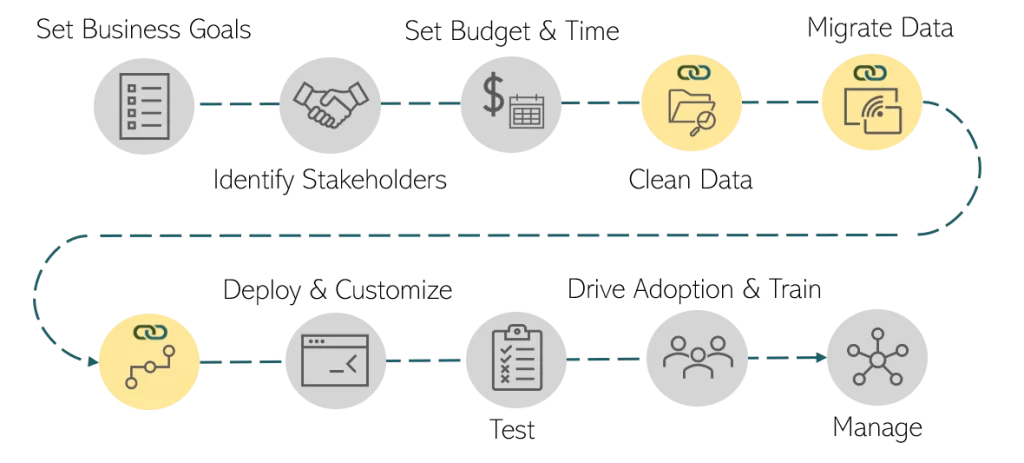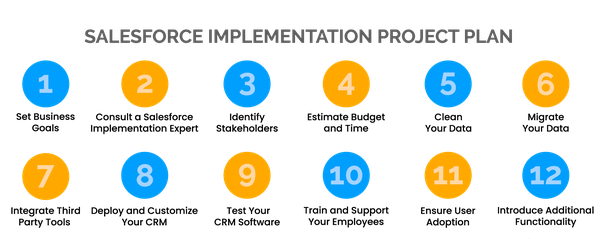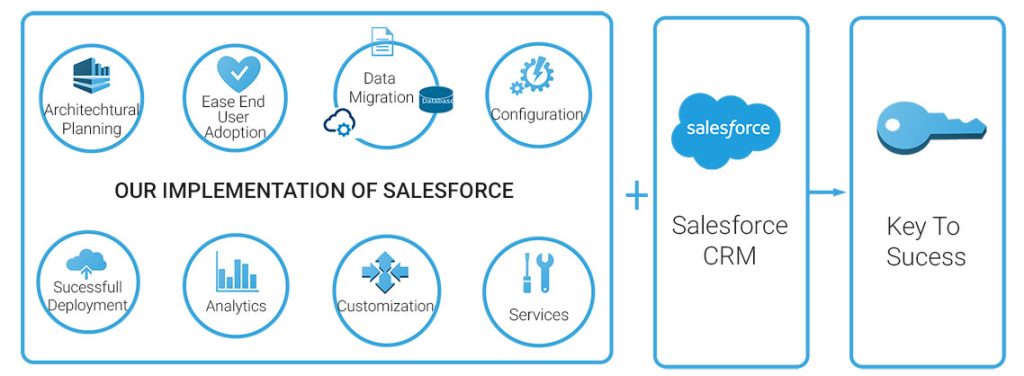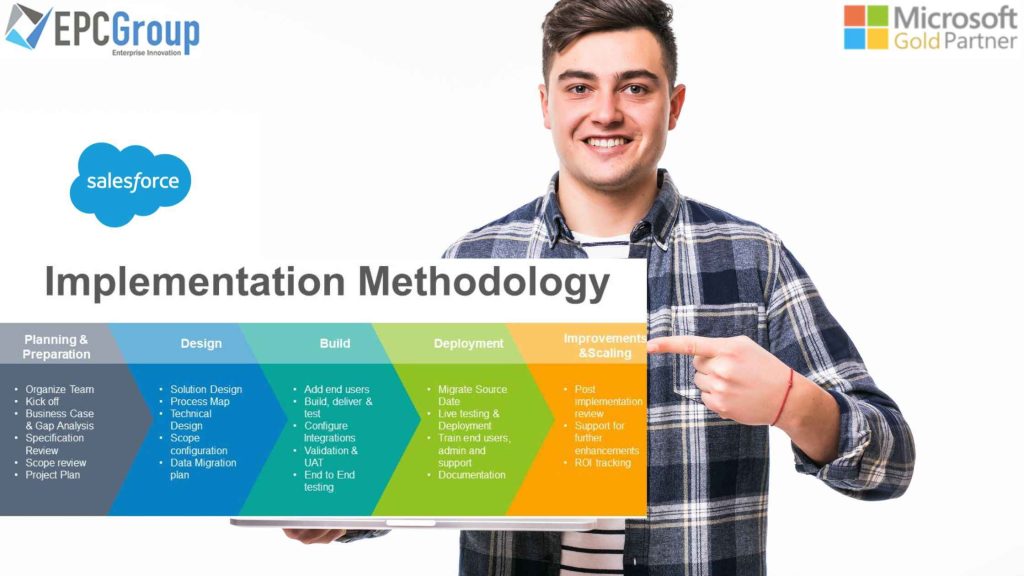Buying the best CRM license is the first step in creating and carrying out any Salesforce implementation strategy. Knowing how to modify and adjust it for your own business to get the most out of it is the second and most crucial step.
A project manager, a Salesforce CRM consultant, and Salesforce developers are required for a thorough deployment. Still, not all businesses have these internal resources available, especially when starting.
What does this entail for you, then? First, you’ll need someone who can work with your team to assist build an implementation strategy that will work for you if you’re new to sales automation or your system is just starting.
How to Plan and Prepare a Salesforce Implementation
The executive advocate for the project should be involved early on and support the effort through go-live and beyond. This individual should be involved both during and after the salesforce implementation. The administrator must know the managerial and user requirements and business procedures. Consult the Best Practice paper “Achieving exceptional administration” for administrators’ resource planning details.
Determine who will take on this role as early in planning as possible. The best candidates are those who have experience in leading large implementations, who can get buy-in from colleagues, and who can manage their workloads effectively.
For example, suppose you have been working with a large enterprise organization using Salesforce CRM for years. In that case, someone with an established track record of success may be a good choice because they could lead the team toward success while still honoring their other commitments. On the other hand, if your organization is a startup or small company just getting started on CRM, you might want someone with experience at a similar growth stage to help guide some of your organization’s most difficult transformations.
3 Tips For Your Successful Salesforce Implementation
It’s crucial to bear in mind that a successful implementation of salesforce deployment will be a dynamic, continuing process as you make your plans. We advise that you roll out functionality frequently and early to obtain the maximum return on your investment. Start with modest objectives that align with your broader vision, then expand upon them.
As you are probably aware, Salesforce is a powerful CRM platform that can help your company achieve its goals. But before you can implement it, you need to know what those goals are:
- Determine how Salesforce implementation fits with your broader business objective before anything else. For instance, you could wish to concentrate on forecasting and management of the pipeline.
- Define first-step goals that support your vision and may be expanded after deployment.
- Finally, list your criteria in order of priority. After collecting data from your business and end customers, map the needs to the goals and overarching vision. For instance, you should ensure that the capability exists since your customers might wish to “monitor tasks and occurrences.”

How To Transfer Customer Data to The Salesforce
You’ll already have data, whether switching from another program or just keeping track of client data in programs like spreadsheets. If data is not examined and sanitized early in a project, it will always become a bottleneck. Most consumers underestimate the work involved in cleaning, mapping, and loading data. Once your system is configured, including your role hierarchy, sharing model, and sharing rules, you should not load data.
When you are ready to transfer customer data, you must ensure that your organization’s defaults, roles, and user profiles are set correctly. Logging in with various roles and profiles will allow you to test those settings. Check that the fields are in the correct order and required fields and that each sort of user may see, add, and update information as necessary. To ensure all users are assigned the appropriate roles when you go live, it’s also crucial to map all the roles to the users you will add to the system.
What’s The Difference Between Waterfall vs. Scrum in Salesforce?
Although Salesforce is an excellent tool for laying the groundwork for your sales process, it’s crucial to remember that you may use it for purposes. For example, the two most popular are the “waterfall” and “scrum” strategies. The waterfall technique is a conventional, sequential, stepwise strategy that might cause the salesforce installation schedule to take longer than expected. On the other hand, small functionality units are continually being developed, delivered, revisited, and improved upon according to the scrum methodology.
Once we have a baseline of capability, we supply new upgrades with our regular releases, and we then develop and polish the functionality depending on user input and use cases. For instance, our quotation module had basic capabilities initially released as a pilot. In the next release, which is a beta release, we added more capabilities. We increased the number of features in the following release and made it publicly accessible. As more clients utilize quoting and let us know what they need, we’ll keep adding more features.

How to build and deploy a Salesforce project timeline
The first step in creating a Salesforce project timeline is determining which approach you will use. The waterfall approach requires all requirements to be prioritized and implemented at the beginning of the project. In contrast, the scrum approach allows for short iterations of design, build, and deployment phases for a smaller set of requirements.
You may create your project timetable after deciding on an execution strategy and ranking each need. You must factor the time needed for design, development, and deployment into every schedule. Prioritizing needs is essential for ensuring that any “must-haves” are included in the launch or initial phase. A scrum technique will result in a timetable with quick iterations of the design, development, and deployment stages for a more condensed set of requirements.
All criteria targeted for the initial deployment are included in the design and build phase with the waterfall methodology. Consider what activities, such as data cleansing or territorial mapping, may be completed simultaneously for both strategies to increase efficiency.
Salesforce Implementation and Customization Strategies
There are several methods to personalize Salesforce once you’re ready. The wizard is the most popular approach since it guides you through choosing the fields, data kinds, and other configuration choices your business will require.
When the wizard is finished, you can consider the type of material shown on your sites. For instance, knowing that you require numerous record types for an object and field-level security will be helpful when you add new custom fields and link them in the wizard to the appropriate record type, page layout, and security level.
One client, for instance, added several additional fields to its contacts page, which required customers to scroll a lot. They didn’t fill out many fields as a consequence. Therefore the business had to start again when constructing that page.
How To Achieve User Adoption For Your Implementation of Salesforce
Executive sponsorship sets the stage for user uptake. Therefore, the sponsor must convey enthusiasm and clear expectations during the first deployment. Getting your users on board is crucial after you’re operating. You must assist your users, track adoption, and promote adoption to achieve this. To support your users, you should offer them training sessions on how to use Salesforce and answer their questions about the product. You should also support them when they encounter issues during the implementation of Salesforce.
To measure user adoption and encourage further adoption, you should create metrics that allow you to track progress toward your goals: number of new users created per month, number of new accounts created per month, and number of accounts converted from paper documents into records.

EPC Group can Focus on Your Salesforce CRM Consulting Services
Ultimately, this article will help you build and implement a salesforce implementation plan that works for the state of your organization. If you’re starting with Salesforce and want to start small, you could consider some starter pack templates with various level customizations.
Or, if you have specific needs and your company is flexible with costs, you could partner with a consultant or developer to customize your CRM up-front. You can contact EPC Group to learn a little more about how they work with clients looking to build an implementation of salesforce plan, and they told us that three essential elements have a role in a business’s success in implementing Salesforce.










